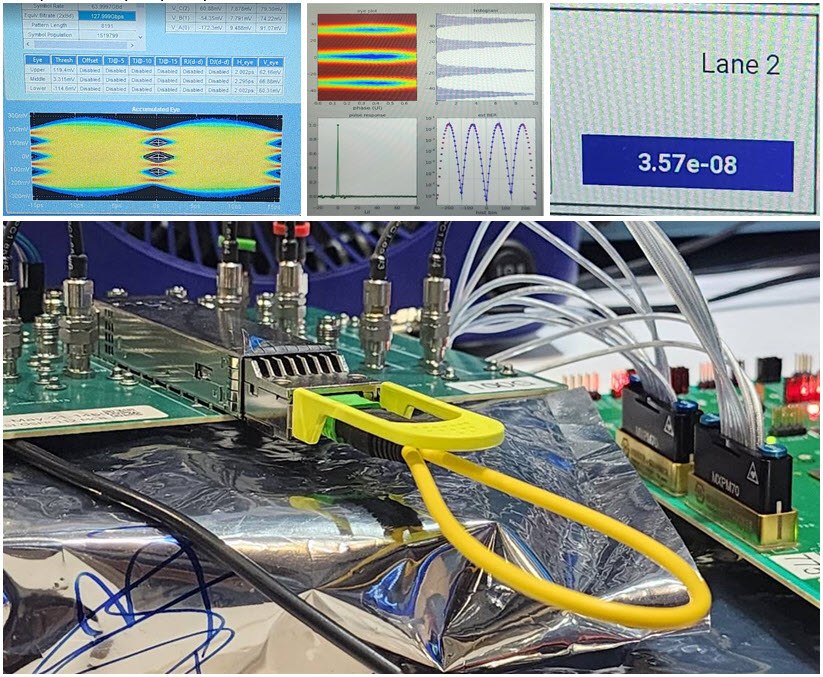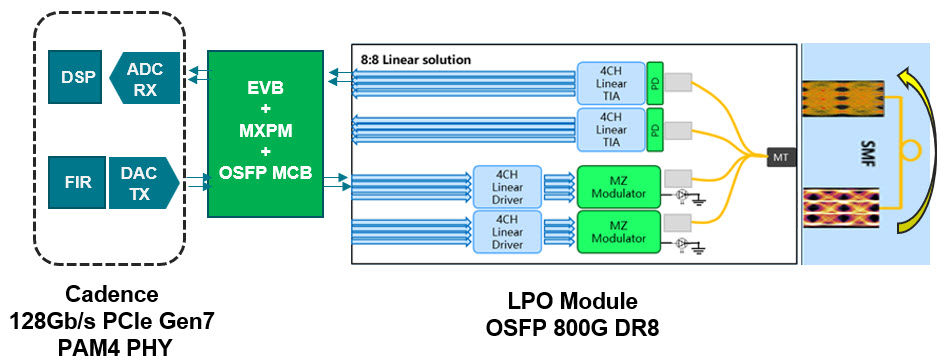Optical PCIe 7.0 connection hits a blazing 128 GT/s
Cadence shows off optical solution for next-generation PCIe 7.0 that is not yet finalized.

Cadence demonstrated its proprietary optical connectivity solution for PCIe 7.0 at the PCI-SIG DevCon 2024 earlier this month. The world's first demonstration of 128 GT/s PCIe 7.0 interconnection over optics is largely a proof-of-concept as the PCIe 7.0 specification is yet to be finalized. However, having a working optical connectivity solution for a standard that is set to be used towards the end of the decade clearly demonstrates Cadence's technical prowess.
During the event, Cadence demonstrated its 128 GT/s PCIe 7.0 IP's transmission and reception capabilities using a real-world, low-latency, non-retimed, linear optical connection. This setup consistently achieved a pre-FEC BER of ~3E-8, well within the PCIe specification requirement of 1E-6, making it the first stable demonstration of 128 GT/s over standard optical connectors. The receiver Eye PAM4 histograms, depicted on an image demonstrated by Cadence, exhibit excellent linearity and margin.
Back in August last year PCI-SIG formed its Optical Workgroup, which will work on industry-standard PCIe over optical interfaces. To this day, PCI Express has relied solely on copper interconnections.
However, because PCIe interconnections are getting longer in applications like AI and HPC servers and usage of retimers is both complicated, expensive and power consuming as well as having its limitations (as only two retimers per link can be used). Therefore, the decision to explore optical connectivity is certainly an important one.
Just like Cadence, there are several other vendors currently provide proprietary external PCIe connectivity solutions. This does not necessarily contradict PCI-SIG's plan to standardize optical PCIe connectivity, as the development of an optical standard seeks to establish a unified approach for PCIe over fiber optics. PCI-SIG emphasized that it is not creating a standard for any specific optical technology, but aims to develop a technology-agnostic specification that supports a broad spectrum of optical technologies.
An optical solution for PCIe 7.0 is something that will be required in the years to come. But Cadence showcased quite a number of PCIe setups, including PCIe 7.0 electrical, and various PCIe 6.0 configurations at the event. These included RP/EP interop back-to-back setups, protocol demonstrations in FLIT mode at both the Cadence and Lecroy booths, JTOL testing with Anritsu and Tektronix equipment, and system-level interoperability demos with a PCIe Gen5 platform at the SerialTek booth.
Get Tom's Hardware's best news and in-depth reviews, straight to your inbox.

Anton Shilov is a contributing writer at Tom’s Hardware. Over the past couple of decades, he has covered everything from CPUs and GPUs to supercomputers and from modern process technologies and latest fab tools to high-tech industry trends.
-
bit_user Cool, so now PCs won't pose only an electrical hazard, but they could also blind you?Reply
: O
Seriously, given the power & wavelengths they're using, what's the potential for eye injury from this class of fiber optics? -
toffty Reply
I'm going to assume there is a negotiation between host and client cards before lines are saturated, in which case 0 chance anyone being able to harm their eyes if they stair at the ends of these cabled and one side is plugged in.bit_user said:Cool, so now PCs won't pose only an electrical hazard, but they could also blind you?
: O
Seriously, given the power & wavelengths they're using, what's the potential for eye injury from this class of fiber optics?
This probably also doesn't use optical light. Fiber optics are usually at 850, 1300, and 1550 nm wavelengths which are above optical light. -
bit_user Reply
I hope you're right, or else PC repair techs better make sure they max out their personal injury insurance & employers better watch out for workmans comp claims!toffty said:I'm going to assume there is a negotiation between host and client cards before lines are saturated, in which case 0 chance anyone being able to harm their eyes if they stare at the ends of these cabled and one side is plugged in.
That might reduce the potential for damage, but I'm sure even non-visible light can cause tissue damage and scarring, given sufficiently high intensity.toffty said:This probably also doesn't use optical light. Fiber optics are usually at 850, 1300, and 1550 nm wavelengths which are above optical light.
To me, it almost seems like a downside that you wouldn't be able to catch a glimpse of a light pattern on the ceiling, before you put your face in the beam path. Maybe they should add a low-intensity visible light component, not to carry information, but just as a visual warning, not unlike the way that "rotten egg" smell is added to natural gas.
Can anyone answer another question I have about this stuff? What's the potential for routing these optics through a PCB, rather than relying on cables? It would seem to be moving backwards, if we suddenly end up with cases full of fiber optic cables going to all the peripheral devices. Not only that, but you must also take care not to bend them too sharply. That would make for very unfriendly tech, IMO. -
kanewolf Reply
Probably no different than any other single mode fiber laser.bit_user said:Cool, so now PCs won't pose only an electrical hazard, but they could also blind you?
: O
Seriously, given the power & wavelengths they're using, what's the potential for eye injury from this class of fiber optics? -
Dementoss Reply
If you're stupid enough to point one into your eye, while it is carrying data, then you probably deserve what's coming to you...bit_user said:Cool, so now PCs won't pose only an electrical hazard, but they could also blind you?
: O
Seriously, given the power & wavelengths they're using, what's the potential for eye injury from this class of fiber optics? -
LabRat 891 I can only imagine the crazy PHY interface, if backwards compatibility is to be retained.Reply
Not really sure how this ever could make its way into the consumer market.
Copper or Optical (or both), a speck off dust, etc. is going to drastically effect the link. -
derekullo Reply
To be fair it isn't just optical light that can blind you/be bad for your eyes.toffty said:I'm going to assume there is a negotiation between host and client cards before lines are saturated, in which case 0 chance anyone being able to harm their eyes if they stair at the ends of these cabled and one side is plugged in.
This probably also doesn't use optical light. Fiber optics are usually at 850, 1300, and 1550 nm wavelengths which are above optical light.
At 850-1550 nm wavelengths that would be infrared light which is literally what we feel as heat.
The real question is what is the amplitude of said infrared beams. -
thestryker With PCIe 7.0 I could really see it launching for enterprise and not propagating down for a while if at all depending on the signaling issues. The large scale manufacturing costs associated with optical have got to be very high and I can't imagine client side ever seeing that and potentially not even workstation.Reply -
LostFate Reply
I wouldn't expect them to use single mode for this, no one is going to negotiate a PCIe link over multiple KM. This will be a low power multimode setup with a power level low enough that you can look directly into the fiber without (much) risk of complication.kanewolf said:Probably no different than any other single mode fiber laser. -
kanewolf Reply
The graphic in the article shows "SMF" which I interpreted as single mode fiber.LostFate said:I wouldn't expect them to use single mode for this, no one is going to negotiate a PCIe link over multiple KM. This will be a low power multimode setup with a power level low enough that you can look directly into the fiber without (much) risk of complication.

